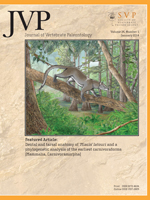Rhinesuchids are a basal group of stereospondyls, one of the most successful groups of early amphibians. They are also the only group of stereospondyl amphibians present prior to the Permian—Triassic boundary. Here, Rhinesuchus postcranial material is sampled for paleohistological analysis for the first time and gives us a model for growth in basal stereospondyls. Bone microstructure confirms an aquatic lifestyle for Rhinesuchus, and indicates that it was a long-lived taxon (>30 years), growing seasonally like other amphibians. The shaft of the iliac dorsal process preserves the largest number of rest lines, suggesting it as a preferred element to estimate minimum age in basal stereospondyls. Femoral diaphyseal sections are readily comparable to distal rib sections for skeletochronological purposes, but preserve fewer rest lines than the ilium. Narrowly banded annuli and rest lines in the inner cortex of Late Permian elements indicate a taxon that was able to weather successive seasons of harsh conditions, and perhaps indicates a reason for the success of Stereopsondyli through the Permo-Triassic mass extinction.
How to translate text using browser tools
1 January 2014
Paleohistology and Histovariability of the Permian Stereospondyl Rhinesuchus
Julia B. Mchugh
ACCESS THE FULL ARTICLE





